Here are some wonderful images taken this year by fellow photographers Mike Peisley, Raelene Neilson, Michael Hines and Ross Naumann. All images reproduced with permission and thanks.

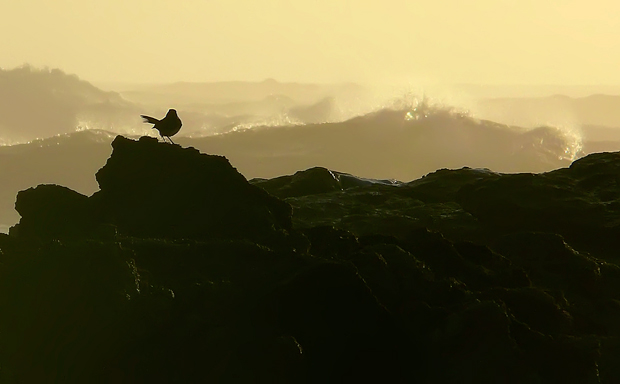
A jaunty-looking Willy Wagtail ponders the surf, North Stradbroke Island. Photo courtesy of, and copyright, Michael Hines.
I don’t usually associate Willie Wagtails (Rhipidura leucophrys) with beaches, but some beautiful images taken at North Stradbroke Island by Michael Hines made me ponder just how ubiquitous these real characters are.
The Willy Wagtail is one of Australia’s most familiar birds, found throughout most of the continent. The name “wagtail” is confusing, because although it flicks and wags its tail from side to side, it is actually a member of the fantail family, and not one of the wagtails of Europe and Asia. [Bird: The DK Definitive Visual Guide]
A bird of many names
The Willie Wagtail was first described by ornithologist John Latham in 1801 as Turdus leucophrys.
John Gould and other early writers referred to the species as the Black-and-white Fantail. However, Willie Wagtail rapidly became widely accepted sometime after 1916. ‘Wagtail’ is derived from its active behaviour, while the origins of ‘Willie’ are obscure. The name had been in use colloquially for the Pied subspecies of the White Wagtail (Motacilla alba) on the Isle of Man and Northern Ireland. Other vernacular names include Shepherd’s Companion (because it accompanied livestock), Frogbird, Morning Bird, and Australian Nightingale.
Many Aboriginal names are onomatopoeic, based on the sound of its scolding call. Djididjidi is a name from the Kimberley, and Djigirridjdjigirridj is used by the Gunwinggu of western Arnhem Land. In Central Australia, southwest of Alice Springs, the Pitjantjatjara word is tjintir-tjintir(pa). Among the Kamilaroi, it is thirrithirri. In Bougainville Island, it is called Tsiropen in the Banoni language from the west coast, and in Awaipa of Kieta district it is Maneka. [Wikipedia]
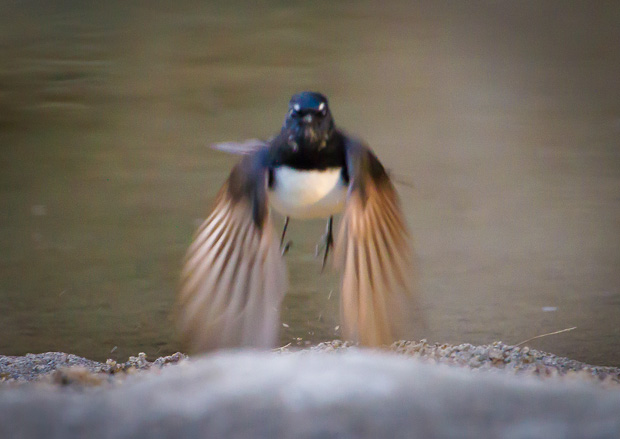
A Willie Wagtail hunting dragonflies, Carnarvon Creek, Carnarvon National Park. Willie (sometimes spelled Willy) Wagtails often hawk for insects along creeks, launching into flight from boulders or other perches. We marvelled at this bird’s ability to snatch fast-moving and wary dragonflies out of the air. Photo R. Ashdown.
Found almost everywhere
Exploring clearings, and familiar in urban areas, Willie Wagatils forage conspicuously in open places and are the only fantails to feed constantly from the ground. Through this capacity they have spread throughout Australia, avoiding only dense forests and treeless, perchless plains. [Reader’s Digest Complete Book of Australian Birds.]
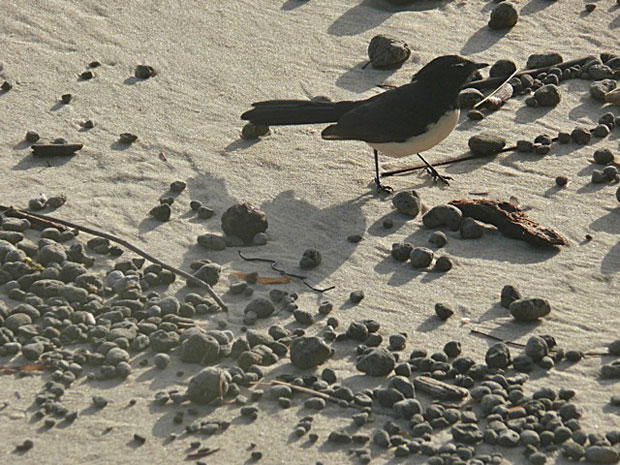
Not your average backyard. Willie Wagtail on sand and pumice, Stradbroke Island. Willie Wagtails are one of five species of fantails (small flycatchers) in Australia. They are found throughout the mainland of Australia and, less commonly, in northern Tasmania. Mainly sedentary or locally nomadic, they tend to be solitary or to occur in pairs, but small flocks may form, where they are often mixed with species such as grey fantails. Photo courtesy of, and copyright, Michael Hines.
Small but fierce, with serious eyebrows
When breeding, Willy Wagtails defend their territory against even large predators, circling their attacker’s head in a figure-of-eight pattern uttering an aggressive ‘ricka-ticka-ticka-tick’. They defend their territory against other wagtails, enlarging their eyebrows in threat. Defeat is signalled by reducing the eyebrows and retreating. [Reader’s Digest Enclyopedia of Australian Wildlife.]
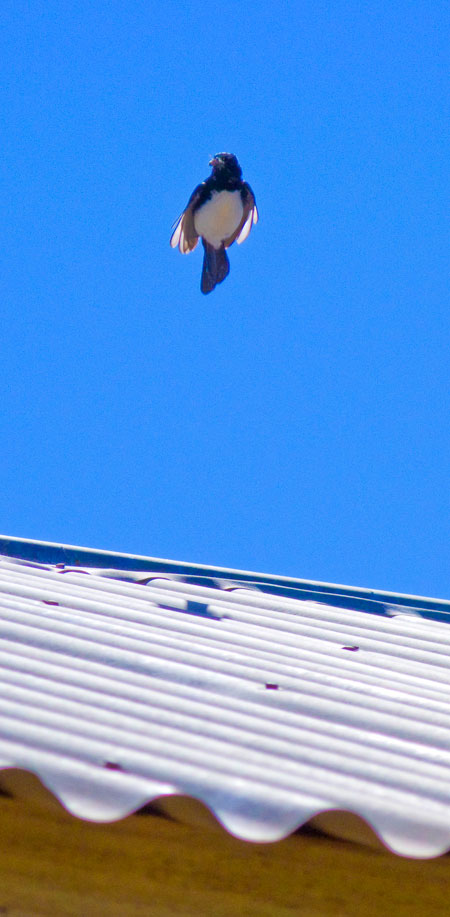
Willie Wagtail in flight above the old shearers’ shed, Currawinya National Park. When driving out west I’m always worried about hitting these birds as they dart out onto roads to grab insects, or to taunt drivers. I remember hearing from someone somewhere that Aboriginal people believe harming a Wagtail will bring you bad luck for years. I once stopped to collect an injured one on the side of the road driving to Carnarvon Gorge (maybe I’d get some ‘luck credit’), but it expired despite my best efforts to keep it breathing. I wondered how such a tiny, frail body could possess such a fierce spirit. On the way home I stopped and buried it near the spot I’d found it, under a tree I reckon it would like. I check out the tree every time I return that way. Photo R. Ashdown.
A big place in human life and story
Aboriginal tribes in parts of south-eastern Australia, such as the Ngarrindjeri of the Lower Murray River, and the Narrunga People of the Yorke Peninsula, regard the Willie Wagtail as the bearer of bad news. It was thought that the Willie Wagtail could steal a person’s secrets while lingering around camps eavesdropping, so women would be tight-lipped in the presence of the Willie Wagtail. The people of the Kimberley held a similar belief that it would inform the spirit of the recently departed if living relatives spoke badly of them. They also venerated the Willie Wagtail as the most intelligent of all animals.
Its cleverness is also seen in a Tinputz tale of Bougainville Island, where Singsing Tongereng (Willie Wagtail) wins a contest among all birds to see who can fly the highest by riding on the back of the eagle. However, the Gunwinggu in western Arnhem Land took a dimmer view and regarded it as a liar and a tattletale. He was held to have stolen fire and tried to extinguish it in the sea in a Dreaming story of the Yindjibarndi people of the central and western Pilbara, and was able to send a strong wind if frightened.
The Kalam people of New Guinea highlands called it Konmayd, and deemed it a good bird; if it came and chattered when a new garden is tilled, then there will be good crops. It is said to be taking care of pigs if it is darting and calling around them. It may also be the manifestation of the ghost of paternal relatives to the Kalam. Called the Kuritoro bird in New Guinea’s eastern highlands, its appearance was significant in the mourning ceremony by a widow for her dead husband. She would offer him banana flowers; the presence of the bird singing nearby would confirm that the dead man’s soul had taken the offering.A tale from the Kieta district of Bougainville Island relates that Maneka, the Willie Wagtail, darting along a river bank echoes a legendary daughter looking for her mother who drowned trying to cross a river flooding in a storm.
The bird has been depicted on postage stamps in Palau and the Solomon Islands, and has also appeared as a character in Australian children’s literature, such as Dot and the Kangaroo (1899), Blinky Bill Grows Up (1935), and Willie Wagtail and Other tales (1929). [Wikipedia]

Side of the highway, Marburg. Photo R. Ashdown.
A spirited and sweet voice
As a child I remember lying in bed at night listening to a strange bird call that would echo off the quiet houses — “sweet pretty creature” — loud and repeated for what seemed forever. Adults had no answers to my questions about this call, and it took me many years to work out that it was a Willie Wagtail. Birder Trevor Hampel has an informative post on his blog Trevor’s Birding about wagtails calling at night.
The nocturnal call of the Willie Wagtail is most commonly heard during moonlit nights and especially during the breeding season (August to February). From my own experience, the presence of a bright street light or car park lighting can also contribute to this phenomenon.
Once started, the song can continue for lengthy periods, often stimulating other birds nearby to also call. It is thought that the nocturnal song in Willie Wagtails is used to maintain its territory. During the night there is no need for parental duties such as feeding the young or protecting the nest, so the song can be used to consolidate the territory. Sound tends to carry further at night and there are fewer sounds in competition and this adds to its effectiveness. It has been found that most nocturnal songs are from a roosting bird some distance away from the nest.
Eats almost anything
The Willie Wagtail is an adaptable bird with an opportunistic diet. It flys from perches to catch insects on the wing, but will also chase prey on the ground. Wagtails eat, among other things, butterflies, moths, flies, beetles, dragonflies, bugs, spiders, centipedes, and millipedes.
They will often hop along the ground behind people and animals, such as cattle, sheep or horses, as they walk over grassed areas, to catch any creatures that they flush out. These birds wag their tails in a horizontal fashion while foraging. Why they do this is unknown but it may help to flush out hidden insects — or maybe they just like wagging their tails. For an in-depth study on the wagging tail of the wagtail, see here.
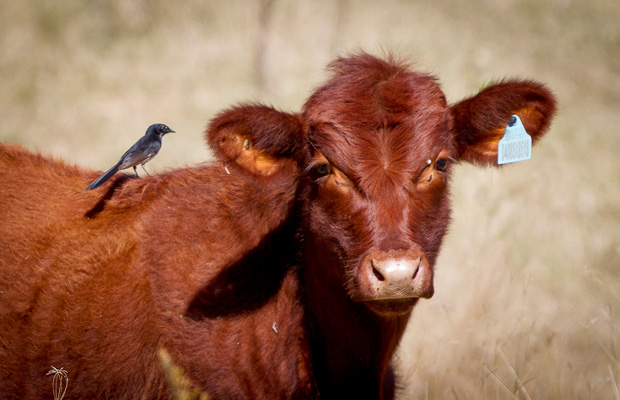
Wagtails take ticks from the skin of grazing animals such as cattle and pigs, and have even been seen doing this with lions in a zoo. Rod Hobson tells of seeing a photograph of one on the head of a crocodile in Papua-New Guinea. Photo R. Ashdown (thanks to Helen and Bill Scanlan).
Determined parents
Willie Wagtails usually pair for life. Anywhere up to four broods may be raised during the breeding season, which lasts from July to December, more often occurring after rain in drier regions.
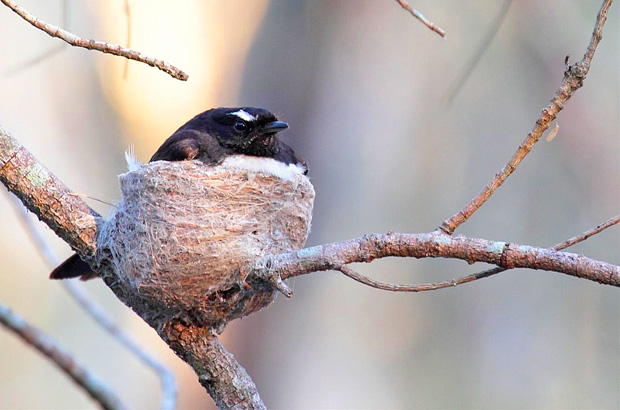
Willie Wagtails build a cup-like nest, made of strips of bark or grass stems, and woven together with spider web or even hair from dogs or cats. They have even been seen trying to get hair from a pet goat. Photo courtesy Mike Peisley.
Wagtails may build nests on or near buildings, and sometimes near the nest of Magpie-larks, perhaps taking advantage of the aggressive and territorial nature of the latter bird, as it will attempt to drive off intruders.
From two to four small cream-white eggs with brownish markings are laid, and these are incubated for about 14 days. Both parents take part in feeding the young, and may continue to do so while embarking on another brood. Nestlings remain in the nest for around 14 days before fledging. Upon leaving, the fledglings will remain hidden in cover nearby for one or two days before venturing further afield. Parents will stop feeding their fledglings near the end of the second week, as the young birds increasingly forage for themselves, and soon afterwards drive them out of the territory. [Wikipedia]
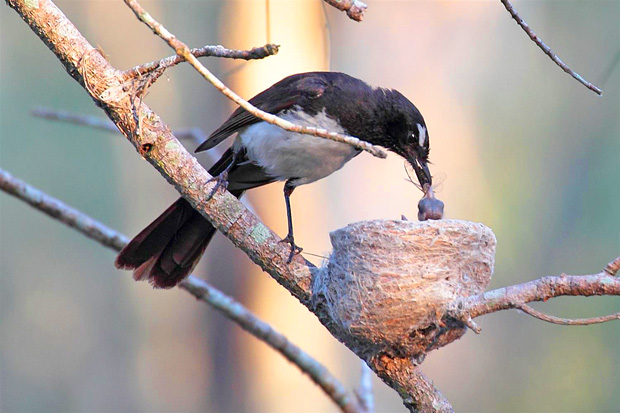
Willie wagtail feeding young. About two-thirds of eggs hatch successfully, while only a third of these leave the nest as fledglings. Young wagtails are taken by other birds, cats and rats. Wagtails will defend the nest aggressively from intruders, and like Australian Magpies, will sometimes swoop at humans. Photo courtesy Mike Peisley.
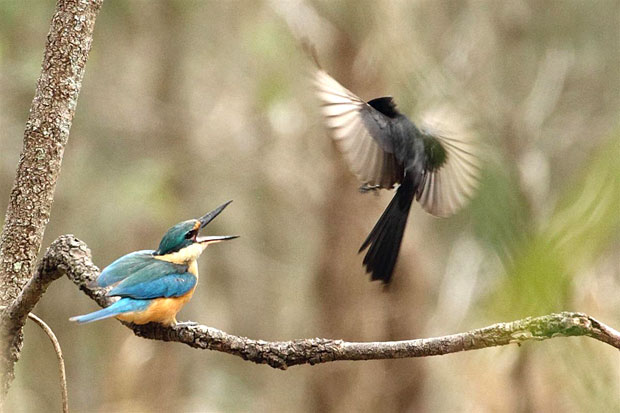
A Wagtail confronts a Sacred Kingfisher that has dared to land in the vicinity of its nest. Photo courtesy Mike Peisley.
The last word
Widespread, well-loved. [Graham Pizzey. The Graham Pizzey and Frank Knight Field Guide to the Birds of Australia.]
Wagtails on the web
Kingfishers and Kookaburras! Vibrant in color, conspicuous in activity and often hilariously raucous, these are some of the most well-known and much loved birds in Australia! Kingfishers and kookaburras are a versatile group. Their colours range across the spectrum. They have adapted to rivers and deserts, to wet rainforests and dry woodlands, to mangrove swamps and islands. They catch lizards, snakes and spiders on the ground, dive underwater for fish, snatch frogs in the tree canopy, and take insects in full flight. — Online review notes of ‘Kingfishers and kookaburras: Jewels of the Australian Bush’, by David Hollands.
There are ten species of kingfisher in Australia. I’ve only seen a few of them, but recently laid eyes on a personal new species — the Red-Backed kingfisher (Todiramphus pyrrhopygia) on the Darling Downs.
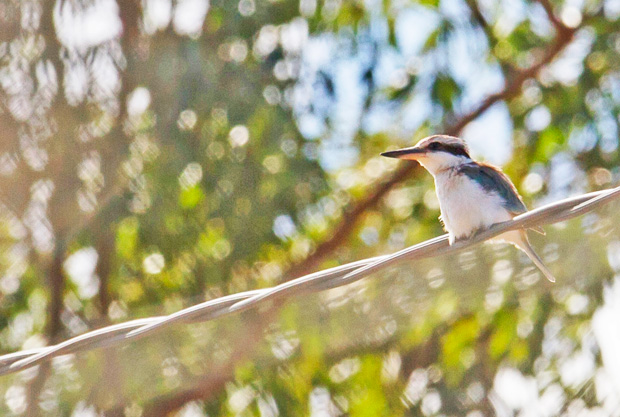
Red-backed Kingfisher (Todiramphus pyrrhopygia), Mount Tyson, Darling Downs. Thanks to spotter extraordinaire Rod Hobson. Photo R. Ashdown.
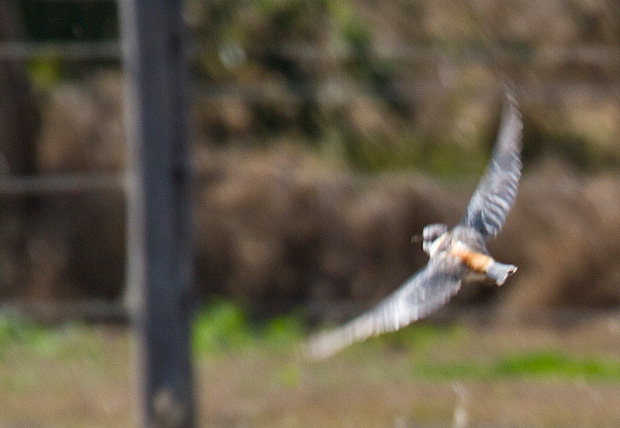
Red back of the Red-backed Kingfisher. These kingfishers inhabit the dry, inland regions of Australia, usually desert, mulga and mallee country. A nomadic species, in dry winter months they may migrate northward or towards the west and north-eastern coast. Photo R. Ashdown.
Whether or not I’ve a camera in hand, it is always a thrill to watch kingfishers. The fleeting, dazzling blue of an azure kingfisher darting across a dark, quiet creek or a muddy mangrove bank seems to me to be like the last piece of a scene’s jigsaw falling into place.
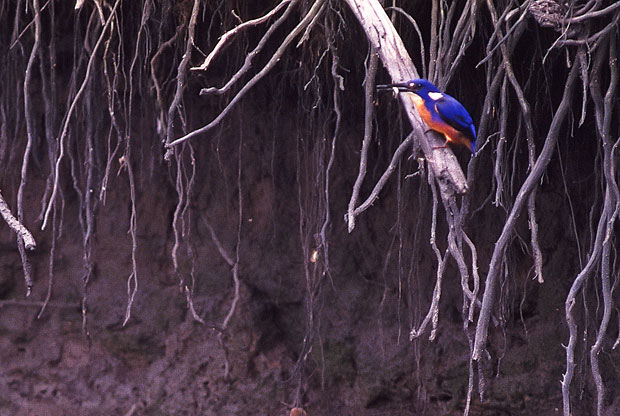
Azure Kingfisher (Alcedo pusilla), Tingalpa Creek. Australia’s smallest kingfisher, with a bill that takes up more than a quarter of its 19cm body length. Photo R. Ashdown.
I’ve always found these birds difficult to photograph. The best results, as is always the case, come with knowing your subject, having incredible patience, and often using a hide and having a big bit of glass stuck to your camera. I haven’t used any of these when it comes to kingfishers – I’ve always ended up in a muddle just snapping away, usually with fairly ordinary results. I did discover that you can get fairly close to kingfishers by using a canoe to sneak up on them – that’s how I took these images of an Azure Kingfisher (above) and a Collared Kingfisher (below) on Tingalpa Creek, where Brisbane’s outskirts meet Redland Bay.
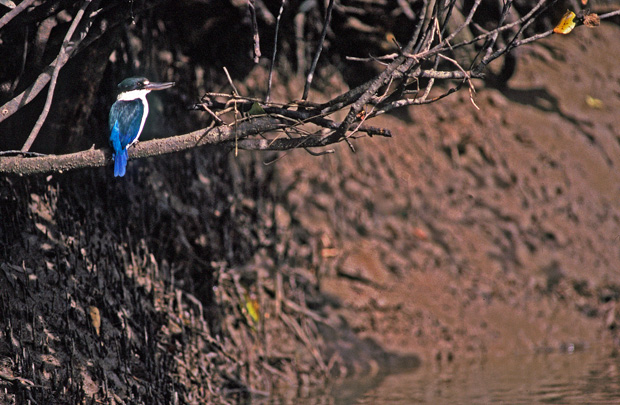
Collared Kingfisher (Todiramphus sanctus), Tingalpa Creek. Sometimes referred to as the Mangrove Kingfisher, this bird lives in the mangroves of Australia’s northern coasts. It eats insects, reptiles and aquatic animals such as worms, which it picks off the mudflats. Photo R. Ashdown.
Through patience and persistence, Mike Peisley has captured taken some excellent images of sacred kingfishers in his local patch of scrub in Brisbane.
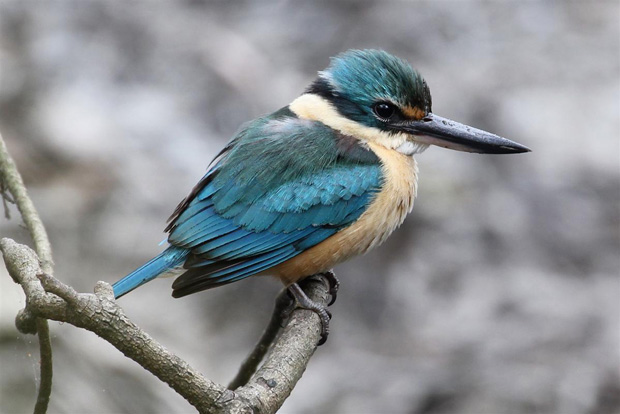
Sacred Kingfisher (Todiramphus sanctus). This is the most familiar, and widespread, of the Australian kingfishers. It spends its day watching for insects and lizards in the leaf litter, but sometimes dives into brackish water for fish or yabbies. This species is found all over Australia, except in the densest rainforests and inland deserts. Photo M. Peisley.
Finally, here are some more images of these adaptable and exquisite birds using any available perch.
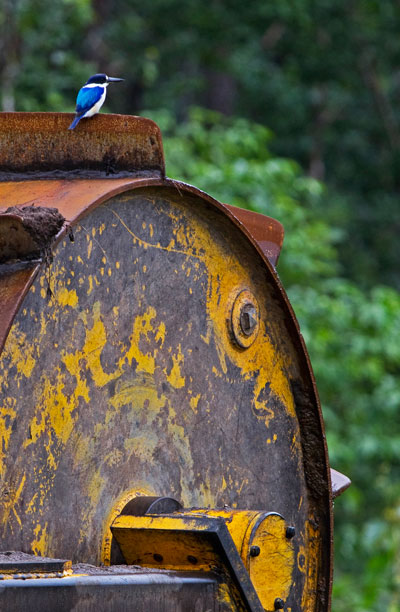
Forest Kingfisher (Todiramphus macleayii), northern Queensland. A bird with royal blue wings, the Forest Kingfisher is a bird of open woodlands, swamps, mangroves and gardens. Photo R. Ashdown.
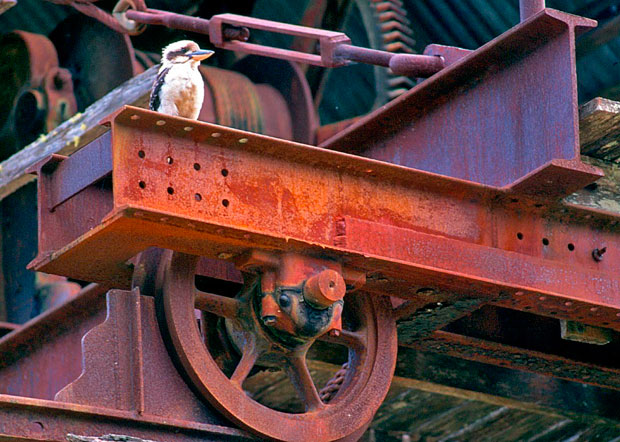
Laughing Kookaburra (Dacelo novaeguineae), Bellthorpe State Forest. A common visitor to Australian gardens, this large kingfisher of the southern and eastern states has been introduced and established in Western Australia, Tasmania and New Zealand. Photo R. Ashdown.
Challenging and enchanting subjects indeed. For anyone seeking a complete immersion in the magical world of Australian kingfishers, track down a copy of the book mentioned at the start of this post: Kingfishers and Kookaburras: Jewels of the Australian Bush, by David Hollands, is a book that truly captures the magic of these birds in all their variety.
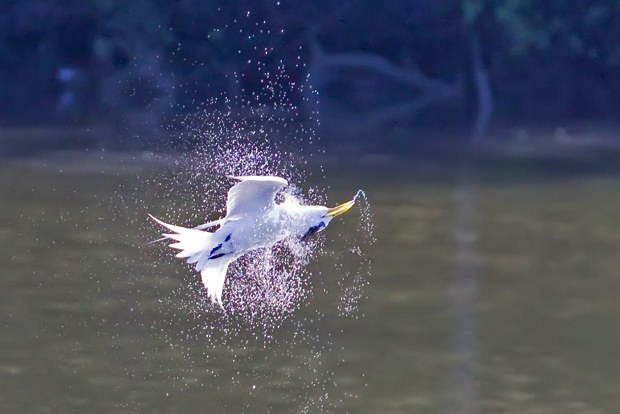
Birds are such great subjects, to photograph or just watch. Can you possibly imagine a world without them? Mike’s photo of the Tern captures a wonderful, always photogenic species — in motion, bursting with energy and life. Great lighting, evocative background, a frozen moment in a bird’s fast-forward life.
Michael’s tattler image immediately pulled me into the scene, the subdued light (morning sun behind clouds?), wonderful colours of the rock, the motion of the surf and the tentative, ever-watchful long-distance traveller, such a natural part of the landscape. I can just smell the beach and the water.
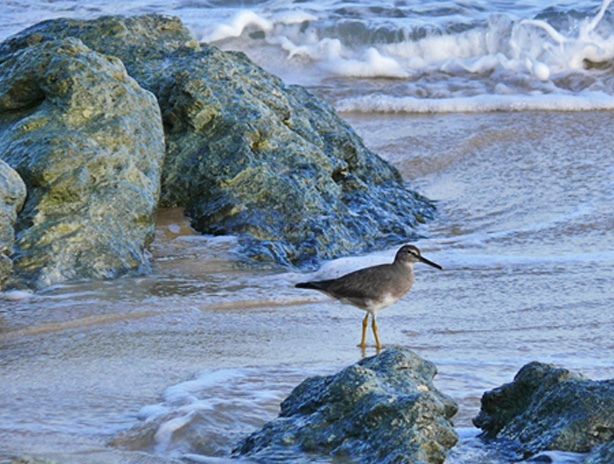
Wandering Tattler (Tringa incana), Deadman's Beach, North Stradbroke Island. Photograph by Michael Hines. A medium-sized shorebird that breeds by mountain streams in Alaska and far eastern Siberia; migrates to southern North America, Central America and northern parts of south America, small islands in the Pacific Ocean, and the east coast of Australia and New Zealand.
There are no rules for good photographs, there are only good photographs. Ansel Adams
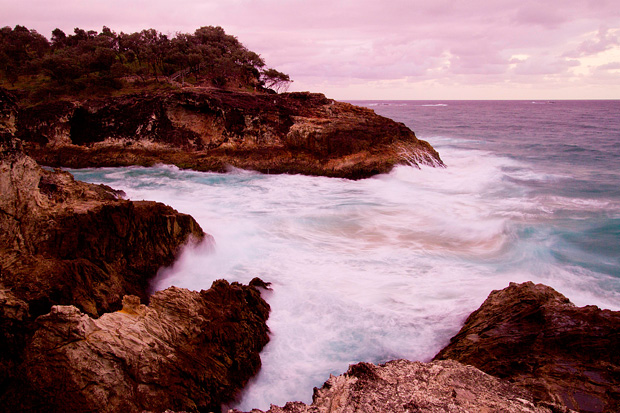
Point Lookout, North Stradbroke Island. At 38km long and 12km at its widest point, “Straddie” is the second largest sand island in the world. A diverse range of habitats on the island support a rich variety of fauna and flora.
Migratory birds seek perpetual summer. However, this is at the cost of repeated punishing ordeals which many of them do not survive. Now they prepared to take wing, not as raptors, gliding are carried on the high, warm currents of the great thermals but as small migrants, storm baffled, frozen, forced down towards demented waves, must pit themselves – perpetually – against nature. Caroline Lassalle, ‘Breaking the Rules’
Mark Simmons and I recently made an all-too-brief working visit to North Stradbroke Island. Driving the beach we noticed many Short-tailed Shearwaters (Ardenna tenuirostris), aka Muttonbirds, washed up dead on the beach.
Local naturalist Michael Hines has been observing this event, and along with Dave Stewart from the Queensland Parks and Wildlife Service, has been interested in estimates of dead bird numbers, and seeking out information on the causes. Stradbroke photographer Glen Caruthers counted 1 carcass every 5 metres for at least 5km, and believed that the final number must have been considerable.
Shearwaters have been turning up dead on many beaches down the east coast of Australia this month, even appearing on Sydney’s beaches. So what’s going on?
The Short-tailed Shearwater is a migratory species. There are an estimated 23 million of these birds, many of which breed on Australian islands in the warmer months. Between June and August the adults and young birds head roughly 9,000km north to feed in the North Pacific Ocean and Bering Sea. The route they take north and south has long been the subject of debate.
The regular passage of these birds back south along the east coast of Australia between October and January is spectacular, and in some years (such as this one), many perish and wash up on beaches. Such an event is known in bird circles as a ‘wreck’. The reasons for wrecks have been discussed at length, but it’s generally agreed that starvation and exhaustion, and the influence of storms and other adverse weather, are the causes.
Here’s what Birds Australia has to say on this latest ‘wreck’:
If the sight of a shearwater washed up on the sand of a deserted beach is a forlorn one, the sight of hundreds of dusky, beachcast ‘muttonbird’ corpses is truly bleak. In the past week or two, large numbers of dead Short-tailed Shearwaters have been reported washing up on a number of beaches in south-eastern Australia, along the coast from South West Rocks south to Nowra on the South Coast of New South Wales at least to Torquay on Victoria’s Surf Coast, with especially large numbers washed up on Wilsons Promontory, and doubtless elsewhere.
This type of event, known as a wreck, occurs periodically, usually in October or early November, soon after the birds have returned to Australian waters on their migration back from the northern Pacific Ocean. By the time they arrive back in Australia, the shearwaters have usually expended most of their energy reserves on the journey. When they reach south-eastern Australia, sometimes they encounter unusual sea-surface temperatures which may affect the availability of their main sources of prey, preventing them from foraging, and they become exhausted. If there are also adverse weather conditions at the same time, such as the southerly gales we experienced a week or two ago, many are unable to deal with the rough conditions due to their fatigue, and large numbers die and are washed up. Sometimes live birds are also washed up, and are too weak to head back out to sea. (Shearwaters regularly cope with such gales when they are out at sea, but they are unable to survive their effects when they are starving and exhausted.)
The phenomenon of the shearwater wreck has been known since the 1850s, and they happen periodically. There was a major wreck in November last year, when tens of thousands of shearwaters were strewn along the coasts New South Wales, Victoria and Tasmania, and there was also another one in late October 2000. There is nothing we can do to avert such catastrophes.
People who find dead shearwaters on the beach should check their legs for numbered metal bands, and all such finds should be reported to the Australian Bird and Bat Banding Scheme. The information researchers can gain from this is crucial to building up a picture of the species’ biology and ecology.
A paper published in 2001 looks at ‘wrecks’ that occurred in the northern hemisphere in the late 90s, and discusses the fine balance between energy expended on these long flights and the need to find food during the flight and upon arrival at their destination or stopping-off points. Seasonal and annual variation in prey densities is thought to have an large effect on the birds during their migrations. [Thanks to Michael Hines for this link].
On Stradbroke we were just wondering whether the local raptors would be taking advantage of this protein bonanza, when we noticed a Brahminy Kite feeding on them. We soon saw a White-bellied Sea Eeagle actually carrying off a dead Shearwater.
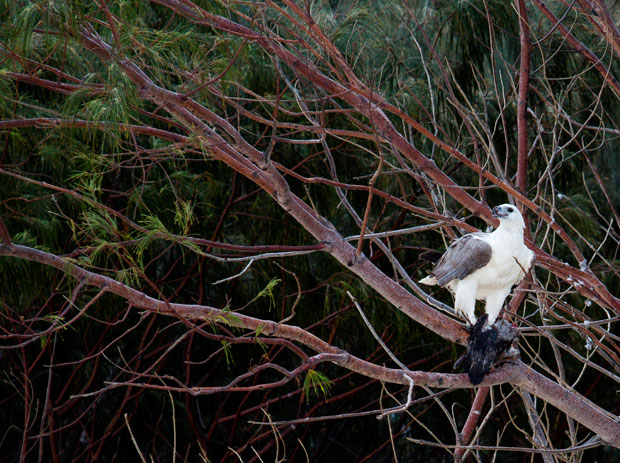
Clearly the dead Shearwaters are a protein bonanza for raptors. There were also local reports of foxes consuming the dead birds.
Another interesting beach-washed bird was a Northern Giant Petrel (Macronectes halli).
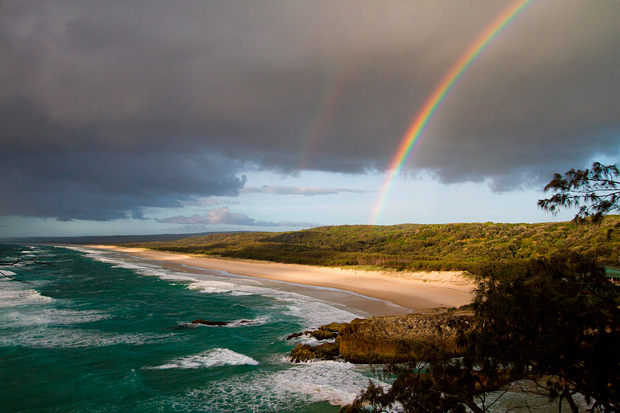
Stradbroke Island is a spectacular place, with locals and visitors alike transfixed by the place’s beauty and abundant wildlife.
Acknowledgement of Country
Minjerribah (North Stradbroke Island) is home to the Nunagal and Goenbal clans who, together with the Ngugi of Mulgumpin (Moreton Island), are the Quandamooka people.
The Quandamooka people are the Traditional Owners of these islands and their waters. They have a rich traditional and living culture and a strong, ongoing connection to Country.
The Quandamooka people’s continued occupation of Minjerribah dates to more than 20,000 years ago.